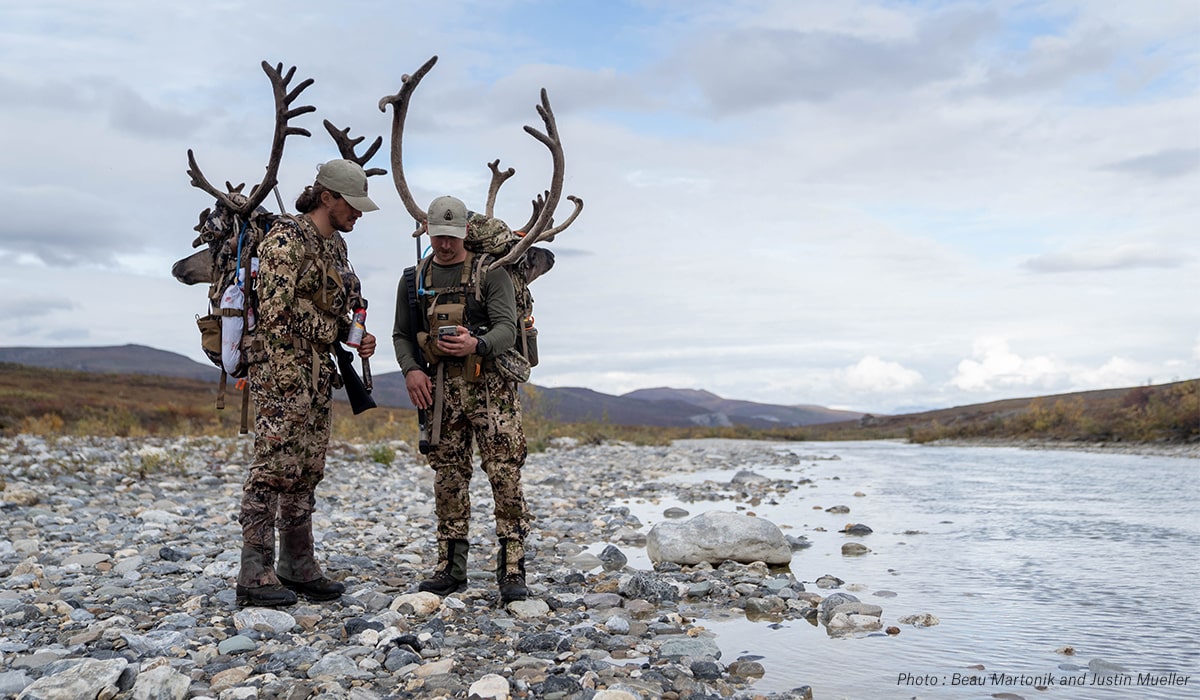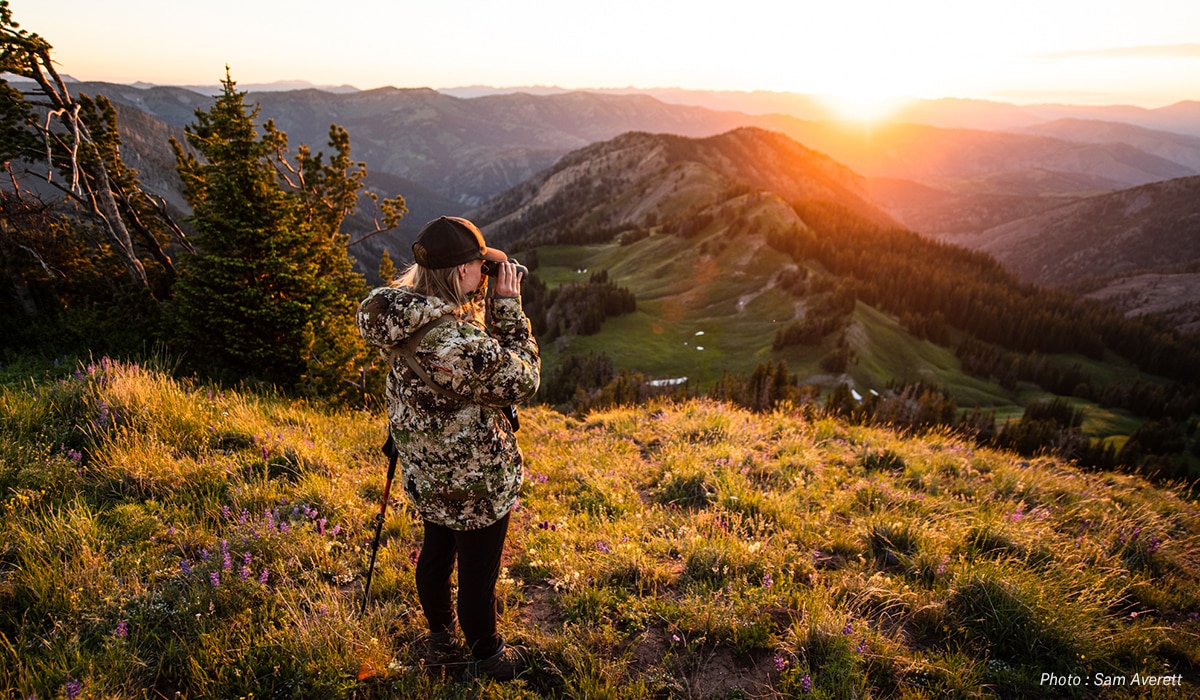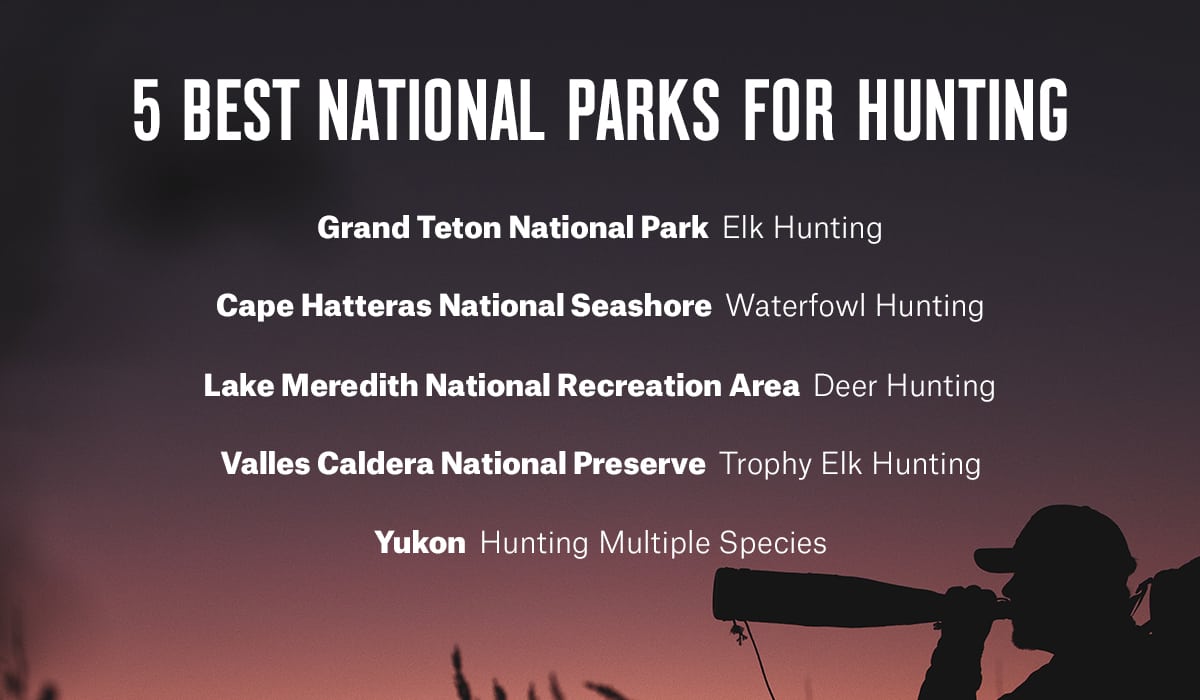Can you hunt in national parks? Yes, some of them, but it’s complicated. In all, 75 of the total 419 units managed by the National Park Service allow some form of recreational, subsistence, or tribal hunting. In terms of size, however, those 75 units make up 60 percent of the National Park system.
Is Hunting Allowed in National Parks?
There is a pervasive myth that hunting is not allowed in national parks, but as we see from the Department of the Interior, there is a substantial amount of national park land available for hunting. Perhaps playing into the misconception about hunting in national parks is that the NPS’s mission is to “conserve the scenery and the natural and historic objects and wildlife therein, and to provide for the enjoyment of the same in such manner and by such means as will leave them unimpaired for the enjoyment of future generations.” Some believe and perpetuate the myth that this mission is counterintuitive to the activity of hunting.

On NPS.gov, however, the case is clearly made that “[h]unters contribute billions of dollars to conservation through revenues from licenses, federal duck stamps, and excise taxes on hunting equipment and ammunition. Some NPS units permit hunting. Staff work with state governments to manage and conserve game species and enhance the safety of hunters and non-hunters.”
It is within this framework that hunters do, in fact, have access to hunt in a number of national parks and NPS-managed units.
National Park Hunting Regulations and Changes
In 2019, the President’s Administration ordered the National Park Service to examine all of its current hunting and fishing regulations where they are stricter than that state’s game laws. The order followed an exercise in 2018 where the Department of Interior compiled a list of national parks that had regulations in place that were more strict than the corresponding state’s. In all, 19 parks had more restrictive hunting regulations and 35 parks had more restrictive fishing regulations.
While the NPS is still working through analyzing and making any changes to those noted parks, in May 2020 Alaska made headlines when the Administration amended restrictions set in 2015 for hunting methods on federal lands in Alaska. The new rules went into effect on July 9, and they now allow hunters and trappers to take (summary via Anchorage Daily News):
• Black bears, including cubs and sows with cubs, with artificial light at den sites.
• Bears using bait.
• Wolves and coyotes, including pups, during the denning season.
• Swimming caribou.
• Caribou from traveling motorboats.
• Black bears using dogs.

How To Hunt in National Parks
Hunting in national parks and NPS-managed units definitely require some additional licenses, permissions, and have strict seasons, limits, and access points. The most important first step to take in order to hunt on NPS lands is to contact the park directly to get the available brochures and applications for permits.
If you’re looking at a particular national park for a hunting trip, turn on the Government Lands Layer in the onX Hunt App. The Government Lands Layer includes properties owned by federal, state, and tribal governments. The areas owned by different government agencies are color-coded, with purple denoting lands owned by the National Park Service. If you need information about using Map Layers in onX Hunt, here’s a step-by-step guide.
It is important to understand that the parks don’t close to the public during these hunting seasons (there may be a few exceptions), so be aware that you will be sharing public lands with non-hunters while you’re in the field.
Which National Parks Allow Hunting?
We have rounded up the national parks that may allow hunting. It is worth noting that each national park has its own regulations, seasons, and methods for obtaining hunting licenses. Follow each link to find out how to apply for a hunting license for each national park.
- Amistad National Recreation Area
- Apostle Islands National Lakeshore
- Assateague Island National Seashore
- Big Cypress National Preserve
- Big South Fork National River & Recreation Area
- Big Thicket National Preserve
- Bighorn Canyon National Recreation Area
- Bluestone National Scenic River
- Buffalo National River
- Cape Cod National Seashore
- Cape Hatteras National Seashore
- Cape Lookout National Seashore
- Chickasaw National Recreation Area
- City Of Rocks National Reserve
- Delaware Water Gap National Recreation Area
- Denali National Park & Preserve
- Fire Island National Seashore
- Gates Of The Arctic National Park & Preserve
- Glacier Bay National Park & Preserve
- Grand Teton National Park
- Great Sand Dunes National Park & Preserve
- Gulf Islands National Seashore
- Jean Lafitte National Historical Park and Preserve
- Katahdin Woods and Waters National Monument
- Lake Clark National Park & Preserve
- Lake Mead National Recreation Area
- Lake Meredith National Recreation Area
- Little River Canyon National Preserve
- Mississippi National River and Recreation Area
- Missouri National Recreational River
- New River Gorge National River
- Niobrara National Scenic River
- Noatak National Preserve
- Oregon Caves National Monument & Preserve
- Ozark National Scenic Riverways
- Pictured Rocks National Lakeshore
- Sleeping Bear Dunes National Lakeshore
- Valles Caldera National Preserve
- Whiskeytown National Recreation Area
- Wrangell – St Elias National Park & Preserve
- Yukon – Charley Rivers National Preserve

5 Best National Parks for Hunting
Each national park, or NPS-managed unit, has its own merits for providing hunters with incredible hunting opportunities. Some have multiple huntable species; others provide amenities like hunting blinds. There are several NPS units that stand out, and we have compiled this shortlist of national parks that are best known for hunting.
1. Best National Park for Elk Hunting – Grand Teton National Park (Wyoming)
Somewhere between early October and early December hunters with a valid Wyoming hunting license, a conservation stamp, and required park permits may participate in the park’s annual elk reduction program. In 2019 the park issued 375 permits to harvest elk in Jackson Elk Herd. According to the park’s Elk Reduction Brochure, there are clearly marked areas within the park where hunting is allowed. It’s imperative for the hunters to know where they stand within those boundaries. We recommend having Wyoming Hunting Maps in your onX Hunt App.
2. Best National Park for Waterfowl Hunting – Cape Hatteras National Seashore (North Carolina)
To hunt waterfowl at Cape Hatteras National Seashore hunters must have a North Carolina hunting license with a North Carolina waterfowl privilege, a Federal Harvest Program (HIP) certification, and a Federal Duck Stamp. It also helps to have the latest North Carolina Hunting Maps. What makes waterfowl hunting exceptional here is the access to NPS-maintained blinds and the ability to bring your own temporary blind. From ducks to geese to Tundra swan, this national seashore is a waterfowler’s paradise.
3. Best National Park for Deer Hunting – Lake Meredith National Recreation Area (Texas)
With an archery season and a general season for whitetails and mule deer, Lake Meredith NRA has a lot to offer. In addition to big game, hunters have seasons for dove, teal, turkey, quail, pheasant, rabbit, and even coyote. This NRA is broken into many different sections, where some areas are archery and shotgun only, and others are closed to hunting altogether. Using the Lake Meredith Hunting Map (PDF) along with the Texas Hunting Maps on onX Hunt will help keep you legal.
4. Best National Park for Trophy Elk Hunting – Valles Caldera National Preserve (New Mexico)
Valles Caldera National Preserve is home to between 2,000 and 2,500 elk who occupy the preserve for breeding, calving and foraging. Hunters must have a special use permit and receive a brief orientation. There are areas within the preserve off-limits to hunting, so it’s important to have New Mexico Hunting Maps with you.
5. Best National Park for Hunting Multiple Species – Yukon – Charley Rivers National Preserve (Alaska)
National preserves in Alaska are made up of over 19 million acres of wildlands, and thanks to the Alaska National Interest Lands Conservation Act passed by Congress in 1980 hunters can hunt for many of the game species native to the state. The number of animals that have hunting seasons in Yukon – Charley Rivers, and other Alaskan National Preserves, include bison, black bear, brown or grizzly bears, caribou, Dall sheep, moose, mountain goat, and wolves. If you plan on hunting in Alaska at any one of these preserves, why not have an Alaska Hunting Map that shows all the preserves and government lands in one place?